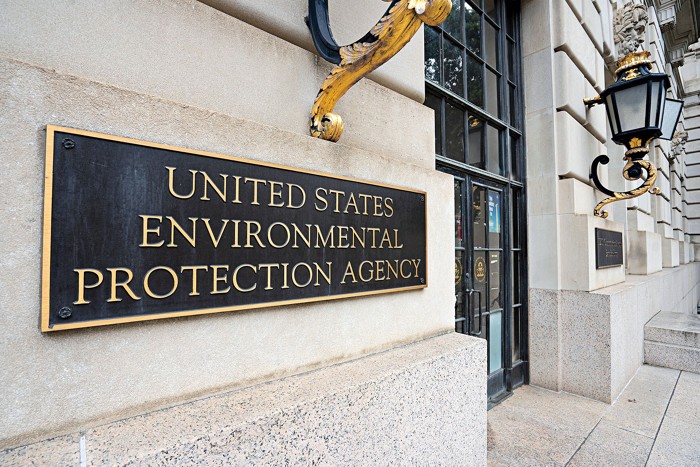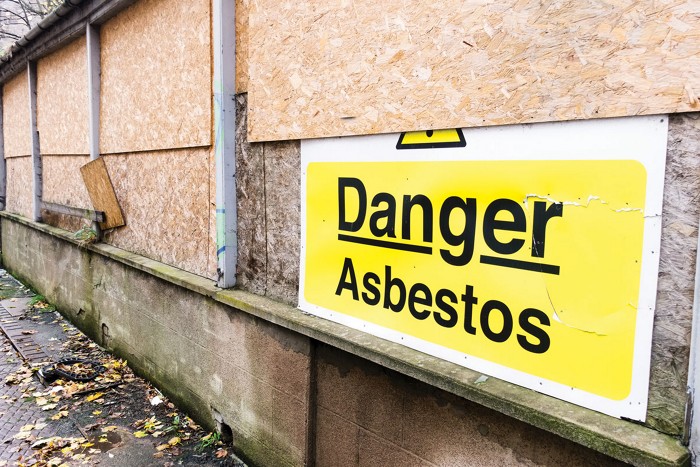Advertisement
Grab your lab coat. Let's get started
Welcome!
Welcome!
Create an account below to get 6 C&EN articles per month, receive newsletters and more - all free.
It seems this is your first time logging in online. Please enter the following information to continue.
As an ACS member you automatically get access to this site. All we need is few more details to create your reading experience.
Not you? Sign in with a different account.
Not you? Sign in with a different account.
ERROR 1
ERROR 1
ERROR 2
ERROR 2
ERROR 2
ERROR 2
ERROR 2
Password and Confirm password must match.
If you have an ACS member number, please enter it here so we can link this account to your membership. (optional)
ERROR 2
ACS values your privacy. By submitting your information, you are gaining access to C&EN and subscribing to our weekly newsletter. We use the information you provide to make your reading experience better, and we will never sell your data to third party members.
Chemical Regulation
The battle over PFAS in Europe
Industry pushes back on government proposal to ban fluoropolymers
by Alex Scott
September 18, 2023
| A version of this story appeared in
Volume 101, Issue 31

A full-scale furor is erupting in Europe, pitting industry against government. The European Commission (EC) is proposing that all per- and polyfluoroalkyl substances (PFAS) be banned because it says they are persistent, can be toxic, and can bioaccumulate in organisms—including people. The ban would include all fluoropolymers, a major subset of PFAS.
European fluoropolymer producers and users are fighting the proposal. They say that fluoropolymers are essential in numerous applications, that they often have no substitutes, and that they present no risk to human health and the environment. Thousands of companies have complained to the EC as part of an online consultation on the proposed legislation.
The argument is coming to a head. Industry will have another opportunity in the coming months to discuss its position with the EC. Various regulatory bodies will then vote on the proposed legislation. If it becomes law, it will come into effect in about 2026. Plenty of heated discussions are expected first.
Fluoropolymers have a carbon-only molecular backbone with fluorine atoms directly attached to it. The market size and diversity of applications are significant. Thousands of types of fluoropolymers are in use across Europe in thousands of products, including low-friction coatings, gaskets, and pipes that are resistant to high temperatures and durable in the presence of most chemicals.
Global fluoropolymer production in 2023 is expected to reach 389,000 metric tons (t) and be worth about $7.9 billion, according to Research and Markets, a market information provider. It forecasts that the market will grow rapidly, rising to 478,000 t in 2026 and a value of $9.6 billion.
Fluoropolymers by the numbers
389,000
metric tons
Amount of fluoropolymers forecast to be made globally in 2023
~$7.9
billion
Estimated value of the global fluoropolymer market in 2023
4.4
million metric tons
Amount of per- and polyfluoroalkyl substances (PFAS) expected to be released globally into the environment over the next 30 years
>2,500
Number of comments made to the European Commission about the proposed ban on PFAS
Sources: Research and Markets; governments of Denmark, Germany, Norway, Sweden, and the Netherlands; European Chemicals Agency.
Industry is vigorously defending the production and use of fluoropolymers and is unequivocal in its claim that they are safe. “There is no scientific basis for banning fluoropolymers,” says Frenk Hulsebosch, senior business director for advanced performance materials at Chemours. “Additionally, any ban would have a significant negative impact on downstream industries because in many applications there are no suitable alternatives.”
Scientists say some PFAS, such as surfactants, can cause cancer, disrupt the endocrine system, and interfere with reproduction and fetal development. Contrastingly, “fluoropolymers are neither water soluble, mobile, nor bioavailable or toxic and are proven to not pose a risk to human health or the environment,” Hulsebosch says.
Many companies acknowledge that PFAS-based surfactants—used to aid the manufacture of some fluoropolymers—should be replaced. Some fluoropolymers can be made only with PFAS-based surfactants.
Moving away from the use of PFAS-based surfactants may not be the complete solution, though. “Whilst technologies exist that don’t use fluorinated surfactants, these give rise to additional manufacturing challenges and in many cases generate PFAS impurities that may also be emitted,” a spokesperson for the fluoropolymer producer AGC Chemicals Europe says in an email.
The French specialty chemical firm Arkema uses fluorosurfactants to make polymers such as polyvinylidene fluoride (PVDF). In a statement earlier this year, the company says it has “initiated a process” to phase out the use of fluorosurfactants globally by the end of 2024.
But the company has a very different view of the production of fluoropolymers. “Arkema does not understand notably why fluoropolymers produced without fluorosurfactants are not exempted from the proposed restriction,” the company says in the statement. “Arkema’s fluoropolymers are considered not to pose risks to human health, have a favorable (eco)toxicological profile, and meet the OECD definition for polymers of low concern,” it says, referring to the Organisation for Economic Co-operation and Development.
But the OECD definition of “polymers of low concern” fails to account for the release of toxic molecules into the environment either during production or at the end of a polymer’s life, says Rainer Lohmann, a professor of oceanography at the University of Rhode Island. Scientists such as Lohmann, along with environmental advocacy groups, say it is during these two phases that fluoropolymers present a significant risk to human health and the environment, even when fluorosurfactants are not involved.
“Given fluoropolymers’ extreme persistence, emissions associated with their production, use, and disposal, and high likelihood for human exposure to PFAS, their production and uses should be curtailed except in cases of essential use,” Lohmann and colleagues write in a 2020 review of the scientific literature on the risks they pose (Environ. Sci. Technol. 2020, DOI: 10.1021/acs.est.0c03244). They add, “The evidence reviewed in this analysis does not find a scientific rationale for concluding that fluoropolymers are of low concern for environmental and human health.”
The 2 sides to the fluoropolymer fight
Why keep them
▸ The Organisation for Economic Co-operation and Development classifies them as polymers of low concern.
▸ Producers say they are inert during use and pose no risk to human health or the environment.
▸ They have few substitutes.
▸ Closed-loop recycling could prevent the release of per- and polyfluoroalkyl substances (PFAS).
▸ They enhance quality of life.
▸ They are a multibillion-dollar industry supporting thousands of applications.
Sources: Arkema, Chemours, International Chemical Secretariat, European member states, Mark R. Crimmin, Rainer Lohmann, C&EN research.
Why ban them
▸ The OECD definition of “polymers of low concern” does not take into account manufacturing or products’ end of life.
▸ Toxic molecules can be released during manufacture and disposal.
▸ Substitutes are available in more than 90% of cases.
▸ They are not recovered from many waste streams.
▸ About 4.4 million metric tons of PFAS, including a substantial amount of fluoropolymers, may enter the environment in the next 30 years.
▸ Once fluoropolymers are in the environment, they do not degrade.
▸ Next-generation fluoropolymers could still be problematic for human health and the environment.
Multiple PFAS, including monomers and oligomers, are emitted during the production, processing, use, and end-of-life treatment of fluoropolymers, the study found. One caveat that Lohmann flags is that different companies have their own manufacturing processes and may release different amounts of toxic molecules. “It’s a big unknown,” Lohmann says in a phone conversation.
When it comes to end-of-life scenarios for fluoropolymers, the study cites areas where toxic PFAS can be released into the environment. For example, fluoropolymers applied to metal, such as coatings used on nonstick frying pans, “might end up in metal recycling streams, leading to their uncontrolled breakdown in metal smelters at high temperatures.”
The Swedish environmental group the International Chemical Secretariat (ChemSec) also highlights disposal concerns. “What happens to fluoropolymers at the end of their life could be a major problem,” says Jonatan Kleimark, senior chemical and business adviser at ChemSec. “We have no idea where they will end up. When they are incinerated, they probably break down into other PFAS.”
Closed-loop production and recycling of fluoropolymers, which results in zero material entering the environment, could protect the environment while enabling industry to continue making them, says Mark R. Crimmin, a chemistry professor at Imperial College London. “We need to think a lot more about circular economy and about stopping these things getting in the environment and then finding ways to repurpose and reuse them,” he says.
Fluorine from fluoropolymers that have reached the end of their lives could be reused in new molecules. Crimmin’s research group is working on ways of doing this with polytetrafluoroethylene (PTFE). The economic and environmental benefits could include saving on the expensive process of mining calcium fluoride to source fluorine, Crimmin says. First, though, “we need economic incentives and ways to be able to recycle and reuse [PFAS],” he says.
Closed-loop recycling is also advocated for by Hydrogen Europe, a low-carbon hydrogen industry association, in a position paper published earlier this year in response to the proposed ban on PFAS. The association’s members use fluoropolymers in a variety of applications, including membranes for electrolyzers that split water into hydrogen and oxygen.
The European Chemicals Agency (ECHA), the EC body responsible for implementing European legislation on chemicals, opened a website in March for industrial organizations, such as Hydrogen Europe, to file comments on the proposed ban. Due to close in a few days, the website has attracted over 2,500 comments. Many of them are from fluoropolymer producers and users calling for the proposed ban to be thrown out or for certain fluoropolymers to be exempted.
In a comment, the German Hydrogen and Fuel Cell Association (DWV) makes the case that not only are PFAS “indispensable,” but the recycling of fluoropolymers used in electrolyzers is already “an overwhelming economic imperative,” meaning manufacturers already have an incentive to recycle them.
The association claims that regulators strictly control PFAS emissions at production sites and that producers undertake the end-of-life incineration of all types of fluoropolymer membranes for electrolyzers and fuel cells—including exhaust gas treatment—in a safe and controlled way. “Certain Members have already started to systematically take back end-of-life products and some argue that in just 5 years there will be no landfilling of PFAS containing components from fuel cells and electrolysers,” the group states.
The rosy picture of closed-loop PFAS recycling presented by DWV and other industry groups is not shared by the governments of Denmark, Germany, Norway, Sweden, and the Netherlands—the five countries that initially proposed the ban on PFAS. They estimate that around 4.4 million metric tons of PFAS will end up in the environment over the next 30 years unless action is taken.
But fluoropolymers are often relatively expensive and used only in applications where there are no alternatives, some fluoropolymer users say. “Fluoroplastics such as PTFE, FEP [fluorinated ethylene propylene], PFA [perfluoroalkoxy alkane] and the 35 other materials in this group are unfortunately indispensable and irreplaceable due to their properties,” Dennis Olschowka, a sales representative for ESZ Wilfried Becker, a German maker of fluoropolymer components, says in a comment to ECHA. “The damage to our further development and our economy will be immense.”
Olschowka’s concerns are echoed in comments to ECHA by PFAS producers and in position papers published by a string of industrial organizations that rely on PFAS to make their products. One such group, the Semiconductor Industry Association, has written several reports explaining how a PFAS ban would fundamentally affect its members’ activities, including the use of photolithography in the production of semiconductors.
Here the development of PFAS-free alternatives “would require total reinvention of many applications,” the organization says. The process of identifying, developing, and scaling up production of a PFAS-free substitute for use in photolithography and then integrating it into a manufacturing process would take 15 years or more, it says.
ChemSec, which has a history of publishing lists of sustainable alternatives to hazardous chemicals, counters industry’s claim that there are few suitable substitutes for fluoropolymers.
“Our conclusion is that less than 10% of fluoropolymer use can be considered essential,” Kleimark says. So-called derogations, which allow PFAS to continue to be used in applications in which no substitutes exist, mean industry has plenty of time to develop alternatives, he says. “When it comes to semiconductors, for example, it’s being exempted from the proposed ban for many years, which means that you won’t need an alternative until maybe 2040.”
In the next phase of the legislative process, the EC plans to seek industry’s view to determine which applications have substitutes available. Those following the development of the legislation expect the EC to make numerous exemptions, especially for PFAS in medical devices, says Charlotte Bucchioni, vice president of energy and industrials at the strategy and consulting firm Capstone. “I do not see a time when regulators will ban something where there are not alternatives,” Bucchioni says.
When it comes to PFAS, as well as categories of chemicals such as biocides and pesticides, the European Union is increasingly taking a precautionary approach in which chemicals are assessed on the basis of their hazard potential and not how the hazard can be managed, Bucchioni says.
“Rather than go through a painstaking analysis of each one of the thousands of PFAS used today, the restriction is taking a ‘read across’ approach, where all the substances in a family are considered as hazardous as the most dangerous member of the family,” Bucchioni says. This is the route least favored by industry. “Europe is taking into account more the citizens rather than the balance sheets of the companies,” she says.
Companies can still request changes to the draft regulation. “But it is very well written,” Bucchioni says. “If industry wants exemptions, they will have to come to ECHA with well-backed-up information. I am pretty confident that industry won’t get everything they want.”
Legally, though, industry may have a case for PFAS to be evaluated individually, says Sascha Arnold, an attorney at Freshfields Bruckhaus Deringer, a law firm whose clients include PFAS producers and users. “I do wonder whether all of the substances considered as PFAS really share the same characteristics down to the molecule so that they can—from a legal perspective—also be treated the same way,” Arnold says.
If there is a case to be made that some PFAS are not as dangerous as others, industry should submit it to the EC as an argument against a ban, he says. “In this case, then there wouldn’t be a legal basis to restrict these substances.”
Advertisement
Producers, in a bid to strengthen their case for allowing the continued use of a fluoropolymer, could also share data with the EC on the amount of PFAS released during the polymer’s manufacture. “I think this is happening,” Arnold says. Whatever occurs next, “the final proposal will most likely look significantly different from the current draft proposal.”
Still, European member states and the European Parliament are likely to come together to vote in favor of a PFAS ban, Bucchioni says. “They’ve seen what has happened with PFAS pollution in the US, and there is general alignment here.”
One thing parties on both sides of the argument agree on is that a ban on PFAS in Europe would be hugely complex to administer. Some companies may be hoping the proposed legislation will be dropped entirely because it is too complicated and hard to implement.
Lohmann doesn’t expect that to happen. “If the EU does not go through with it, basically that means we’ve given up trying to regulate industry,” he says.





Join the conversation
Contact the reporter
Submit a Letter to the Editor for publication
Engage with us on Twitter